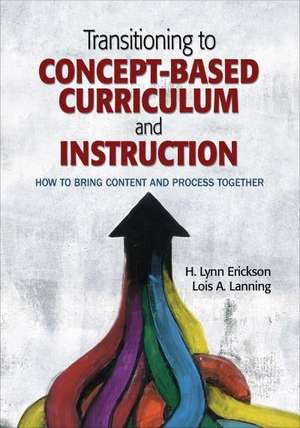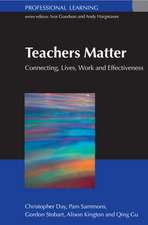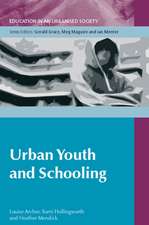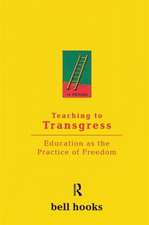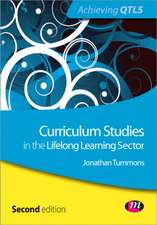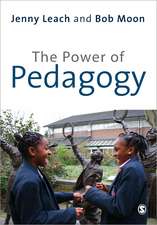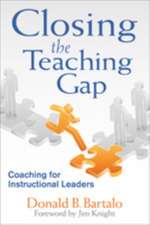Transitioning to Concept-Based Curriculum and Instruction: How to Bring Content and Process Together: Concept-Based Curriculum and Instruction Series
Autor H. Lynn Erickson, Lois A. Lanningen Limba Engleză Paperback – 17 feb 2014
takes a unique approach to the topic of curriculum development by bringing together Lynn Erikson’s Structure of Knowledge and Lois Lanning’s Structure of Process to help educators create Common Core-aligned, concept-based curriculum across subject areas and grade-levels.
Preț: 193.94 lei
Nou
Puncte Express: 291
Preț estimativ în valută:
37.11€ • 38.85$ • 30.71£
37.11€ • 38.85$ • 30.71£
Carte disponibilă
Livrare economică 17-31 martie
Livrare express 01-07 martie pentru 113.56 lei
Preluare comenzi: 021 569.72.76
Specificații
ISBN-13: 9781452290195
ISBN-10: 1452290199
Pagini: 224
Ilustrații: illustrations
Dimensiuni: 178 x 254 x 13 mm
Greutate: 0.45 kg
Ediția:New.
Editura: SAGE Publications
Colecția Corwin
Seria Concept-Based Curriculum and Instruction Series
Locul publicării:Thousand Oaks, United States
ISBN-10: 1452290199
Pagini: 224
Ilustrații: illustrations
Dimensiuni: 178 x 254 x 13 mm
Greutate: 0.45 kg
Ediția:New.
Editura: SAGE Publications
Colecția Corwin
Seria Concept-Based Curriculum and Instruction Series
Locul publicării:Thousand Oaks, United States
Recenzii
"With the onset of the Common Core and new national content standards, concept-based learning is now more crucial than ever. Erickson and Lanning are “ahead of the curve” in providing teachers and curriculum leaders with rich instructional strategies to meet these challenging standards. This is an essential book for planning tomorrow’s curricula today."
"Powerful teaching engages minds with powerful ideas. At its core, such transformative teaching is neither transmission of information nor practice with inert skills. Rather it is a careful choreography between a mind and an idea such that the mind comes to own the idea in a form that is true to the discipline and expansive for the learner. Erickson and Lanning teach teachers to be choreographers of learning—understanding both what makes content worth knowing and how to engage young minds with that content in ways that extend their capacities to understand it at a deep level, use it, transfer it, and ultimately create with it."
"As educators we all think we understand concept-based curriculum, but those who read this text will have a comprehensive understanding of the meaning and value of concept-based curriculum. This text clearly explains concept-based teaching for the educator to use and develop a change in their teaching to effectively reach and engage students in critical thinking that will enable them to be productive citizens and lifelong learners."
"High school department heads take notice! You will want to read this book with your curriculum supervisor and with your teachers before you re-design your courses to align with the aspirations of the CCSS and NGSS. The curriculum model and specific examples in this book provide you with a clear guide for designing complex, intellectually stimulating curriculum while integrating the new standards."
"Providing today’s students with the skills to become critical, analytical, and life-long learners is an obligation each teacher must make. The authors present a clear path to transition from fact-based learning curriculum to concept-based curriculum. They have provided us with a clear, researched-based approach to help us advocate at our school and district level to make this critical change in curriculum."
"Powerful teaching engages minds with powerful ideas. At its core, such transformative teaching is neither transmission of information nor practice with inert skills. Rather it is a careful choreography between a mind and an idea such that the mind comes to own the idea in a form that is true to the discipline and expansive for the learner. Erickson and Lanning teach teachers to be choreographers of learning—understanding both what makes content worth knowing and how to engage young minds with that content in ways that extend their capacities to understand it at a deep level, use it, transfer it, and ultimately create with it."
"As educators we all think we understand concept-based curriculum, but those who read this text will have a comprehensive understanding of the meaning and value of concept-based curriculum. This text clearly explains concept-based teaching for the educator to use and develop a change in their teaching to effectively reach and engage students in critical thinking that will enable them to be productive citizens and lifelong learners."
"High school department heads take notice! You will want to read this book with your curriculum supervisor and with your teachers before you re-design your courses to align with the aspirations of the CCSS and NGSS. The curriculum model and specific examples in this book provide you with a clear guide for designing complex, intellectually stimulating curriculum while integrating the new standards."
"Providing today’s students with the skills to become critical, analytical, and life-long learners is an obligation each teacher must make. The authors present a clear path to transition from fact-based learning curriculum to concept-based curriculum. They have provided us with a clear, researched-based approach to help us advocate at our school and district level to make this critical change in curriculum."
Cuprins
List of Figures and Tables
Foreword by Malcolm Nicolson
Acknowledgments
About the Authors
Introduction
Purpose of the Book
Audiences
Chapter Overview
Chapter 1. Curriculum Design: From an Objectives-Based to a Concept-Based Model
A Short Retrospective, From the Authors, on Educational Swings
The Value of Know, Understand, and Able to Do in Concept-Based Models
Problems With Traditional Content Objectives
Discussion Questions
Summary
Chapter 2. Two-Dimensional Versus Three-Dimensional Curriculum Models
Contrasting the Two-Dimensional and Three-Dimensional Models
Introducing the Structures of Knowledge and Process
The Interplay of Process and Knowledge
Contrasting Instructional Descriptions
Discussion Questions
Summary
Chapter 3. The Structure of Knowledge
Understanding the Relationships in the Structure of Knowledge
How the Structure of Knowledge Guides Curriculum Design
Designing Disciplinary Curriculum Frameworks at the National, State, or Local Levels
Mathematics as a Concept-Driven Discipline
Examples of Concepts and Subject-Specific Generalizations
Discussion Questions
Summary
Chapter 4. The Structure of Process
The Structure of Process
How the Structure of Process Guides Curriculum and Instruction
Discussion Questions
Summary
Chapter 5. The Developing Concept-Based Teacher
Bridging the Gaps Between Knowing, Doing, and Understanding
Collaborative Concept-Based Lesson Planning
Common Terminology Used to Describe Quality Instruction
The Developing Concept-Based Teacher
Do The Developing Concept-Based Teacher Rubrics Have a Place in Teacher Evaluation Plans?
Discussion Questions
Summary
Chapter 6. The Developing Concept-Based Student
What About Thinking?
The Relationship Between Critical Thinking and Concept-Based Teaching and Learning
Developing Critical Thinking
The Developing Concept-Based Student
Why These Categories?
Discussion Questions
Summary
Chapter 7. What Do Teachers Need to Understand About Concept-Based Pedagogy?
The What and Why of Concept-Based Curriculum and Instruction
The How of Concept-Based Curriculum and Instruction
Four Critical Aspects of Concept-Based Pedagogy
Quality Pedagogy
Concept-Based Classrooms
Discussion Questions
Summary
Chapter 8. What Do Principals and Instructional Coaches Need to Understand? Implementing and Sustaining Concept-Based Curricular and Instructional Models in Schools
Setting the Stage for Curriculum Implementation
Staff Development
Staff Support With Accountability: Building System-Wide Synergy
The Collection and Analysis of the "Right" Data
Discussion Questions
Summary
Chapter 9. What Do District Leaders Need to Understand About Concept-Based Curriculum Designs?
District Leaders Discuss Concept-Based Curriculum and Instruction
Discussion Questions
Summary
Chapter 10. Summary and the Road Ahead
Curriculum and Instruction: The Warp
Concept-Based Learning: The Weft
The Path Forward
Discussion Questions
Resources
Resource A. Concept-Based Mathematics Unit
Resource B. Concept-Based Science Unit
Resource C. Concept-Based Art Unit
Resource D. Concept-Based World Language Unit
Resource E. Concept-Based Music Unit
Resource F. Adapted Learning Activities for Chapter 7
References
Index
Foreword by Malcolm Nicolson
Acknowledgments
About the Authors
Introduction
Purpose of the Book
Audiences
Chapter Overview
Chapter 1. Curriculum Design: From an Objectives-Based to a Concept-Based Model
A Short Retrospective, From the Authors, on Educational Swings
The Value of Know, Understand, and Able to Do in Concept-Based Models
Problems With Traditional Content Objectives
Discussion Questions
Summary
Chapter 2. Two-Dimensional Versus Three-Dimensional Curriculum Models
Contrasting the Two-Dimensional and Three-Dimensional Models
Introducing the Structures of Knowledge and Process
The Interplay of Process and Knowledge
Contrasting Instructional Descriptions
Discussion Questions
Summary
Chapter 3. The Structure of Knowledge
Understanding the Relationships in the Structure of Knowledge
How the Structure of Knowledge Guides Curriculum Design
Designing Disciplinary Curriculum Frameworks at the National, State, or Local Levels
Mathematics as a Concept-Driven Discipline
Examples of Concepts and Subject-Specific Generalizations
Discussion Questions
Summary
Chapter 4. The Structure of Process
The Structure of Process
How the Structure of Process Guides Curriculum and Instruction
Discussion Questions
Summary
Chapter 5. The Developing Concept-Based Teacher
Bridging the Gaps Between Knowing, Doing, and Understanding
Collaborative Concept-Based Lesson Planning
Common Terminology Used to Describe Quality Instruction
The Developing Concept-Based Teacher
Do The Developing Concept-Based Teacher Rubrics Have a Place in Teacher Evaluation Plans?
Discussion Questions
Summary
Chapter 6. The Developing Concept-Based Student
What About Thinking?
The Relationship Between Critical Thinking and Concept-Based Teaching and Learning
Developing Critical Thinking
The Developing Concept-Based Student
Why These Categories?
Discussion Questions
Summary
Chapter 7. What Do Teachers Need to Understand About Concept-Based Pedagogy?
The What and Why of Concept-Based Curriculum and Instruction
The How of Concept-Based Curriculum and Instruction
Four Critical Aspects of Concept-Based Pedagogy
Quality Pedagogy
Concept-Based Classrooms
Discussion Questions
Summary
Chapter 8. What Do Principals and Instructional Coaches Need to Understand? Implementing and Sustaining Concept-Based Curricular and Instructional Models in Schools
Setting the Stage for Curriculum Implementation
Staff Development
Staff Support With Accountability: Building System-Wide Synergy
The Collection and Analysis of the "Right" Data
Discussion Questions
Summary
Chapter 9. What Do District Leaders Need to Understand About Concept-Based Curriculum Designs?
District Leaders Discuss Concept-Based Curriculum and Instruction
Discussion Questions
Summary
Chapter 10. Summary and the Road Ahead
Curriculum and Instruction: The Warp
Concept-Based Learning: The Weft
The Path Forward
Discussion Questions
Resources
Resource A. Concept-Based Mathematics Unit
Resource B. Concept-Based Science Unit
Resource C. Concept-Based Art Unit
Resource D. Concept-Based World Language Unit
Resource E. Concept-Based Music Unit
Resource F. Adapted Learning Activities for Chapter 7
References
Index
Notă biografică
Descriere
A must-have for teachers, curriculum designers, and school leader, providing them with everything they need to know about developing curriculum and instruction for the K-12 classroom, tying in with the Common Core State Standards.
